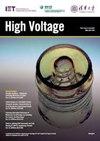基于绕组等效热参数的变压器热点温度快速计算
IF 4.9
2区 工程技术
Q1 ENGINEERING, ELECTRICAL & ELECTRONIC
引用次数: 0
摘要
变压器的热点温度是反映变压器运行状态的重要指标之一。准确、快速地计算热点温度对变压器的在线监测具有重要意义。针对变压器数值全模型(FM)计算效率较低的问题,提出了一种基于绕组等效热参数的模型简化方法,以加快热点温度的计算。首先选取反映绕组周期结构的代表性体积元(RVE),建立变压器的简化模型(RM)。随后,为了实现RM和FM之间的等效,计算RVE的等效热参数,包括等效导热系数(ETC)、等效密度(ED)和等效比热容(ESHC)。最后,通过温升试验验证了模型的有效性。结果表明,与实测数据相比,RM计算的热点温度最大误差为2.56 K,证明了RM计算热点温度的准确性。与调频算法相比,该算法的计算时间缩短至1/189,显著提高了计算效率。本文章由计算机程序翻译,如有差异,请以英文原文为准。
Fast Calculation of Transformer Hot Spot Temperature Based on Winding Equivalent Thermal Parameters
The hot spot temperature of a transformer is one of the critical indicators reflecting its operating status. Accurate and fast calculation of hot spot temperature is significant for the online monitoring of transformers. Considering the low computational efficiency of the transformer’s numerical full model (FM), this paper presents a model simplification method based on the equivalent thermal parameters of windings to expedite hot spot temperature computation. Initially, the representative volume element (RVE) reflecting the periodic structure of windings is selected to formulate a reduced model (RM) for the transformer. Subsequently, to achieve equivalence between the RM and the FM, the equivalent thermal parameters of the RVE are calculated, containing the equivalent thermal conductivity (ETC), the equivalent density (ED), and the equivalent specific heat capacity (ESHC). Finally, the validity of the RM is verified by the temperature rise test. The results show that, compared with the tested data, the maximum error of the hot spot temperature calculated by the RM is 2.56 K, demonstrating the accuracy of the hot spot temperature calculation by the RM. Compared with the FM, the computing time of the proposed RM is reduced to 1/189, which significantly improves the computational efficiency.
求助全文
通过发布文献求助,成功后即可免费获取论文全文。
去求助
来源期刊

High Voltage
Energy-Energy Engineering and Power Technology
CiteScore
9.60
自引率
27.30%
发文量
97
审稿时长
21 weeks
期刊介绍:
High Voltage aims to attract original research papers and review articles. The scope covers high-voltage power engineering and high voltage applications, including experimental, computational (including simulation and modelling) and theoretical studies, which include:
Electrical Insulation
● Outdoor, indoor, solid, liquid and gas insulation
● Transient voltages and overvoltage protection
● Nano-dielectrics and new insulation materials
● Condition monitoring and maintenance
Discharge and plasmas, pulsed power
● Electrical discharge, plasma generation and applications
● Interactions of plasma with surfaces
● Pulsed power science and technology
High-field effects
● Computation, measurements of Intensive Electromagnetic Field
● Electromagnetic compatibility
● Biomedical effects
● Environmental effects and protection
High Voltage Engineering
● Design problems, testing and measuring techniques
● Equipment development and asset management
● Smart Grid, live line working
● AC/DC power electronics
● UHV power transmission
Special Issues. Call for papers:
Interface Charging Phenomena for Dielectric Materials - https://digital-library.theiet.org/files/HVE_CFP_ICP.pdf
Emerging Materials For High Voltage Applications - https://digital-library.theiet.org/files/HVE_CFP_EMHVA.pdf
 求助内容:
求助内容: 应助结果提醒方式:
应助结果提醒方式:


